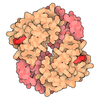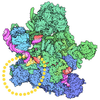+ Open data
Open data
- Basic information
Basic information
| Entry | Database: PDB / ID: 9q22 | ||||||
|---|---|---|---|---|---|---|---|
| Title | Crystal structure of ternary complex Helios-ZF2:I-19:CRBN:DDB1 | ||||||
 Components Components |
| ||||||
 Keywords Keywords | LIGASE / CEREBLON / DEGRADER / HELIOS / IKZF2 / DDB1 / MOCLECULAR GLUE | ||||||
| Function / homology |  Function and homology information Function and homology informationnegative regulation of monoatomic ion transmembrane transport / positive regulation by virus of viral protein levels in host cell / spindle assembly involved in female meiosis / epigenetic programming in the zygotic pronuclei / UV-damage excision repair / biological process involved in interaction with symbiont / regulation of mitotic cell cycle phase transition / WD40-repeat domain binding / Cul4A-RING E3 ubiquitin ligase complex / Cul4-RING E3 ubiquitin ligase complex ...negative regulation of monoatomic ion transmembrane transport / positive regulation by virus of viral protein levels in host cell / spindle assembly involved in female meiosis / epigenetic programming in the zygotic pronuclei / UV-damage excision repair / biological process involved in interaction with symbiont / regulation of mitotic cell cycle phase transition / WD40-repeat domain binding / Cul4A-RING E3 ubiquitin ligase complex / Cul4-RING E3 ubiquitin ligase complex / Cul4B-RING E3 ubiquitin ligase complex / ubiquitin ligase complex scaffold activity / negative regulation of reproductive process / negative regulation of developmental process / locomotory exploration behavior / cullin family protein binding / viral release from host cell / positive regulation of Wnt signaling pathway / ectopic germ cell programmed cell death / negative regulation of protein-containing complex assembly / positive regulation of viral genome replication / proteasomal protein catabolic process / positive regulation of gluconeogenesis / nucleotide-excision repair / positive regulation of protein-containing complex assembly / Recognition of DNA damage by PCNA-containing replication complex / regulation of circadian rhythm / DNA Damage Recognition in GG-NER / Dual Incision in GG-NER / Transcription-Coupled Nucleotide Excision Repair (TC-NER) / Formation of TC-NER Pre-Incision Complex / Formation of Incision Complex in GG-NER / Wnt signaling pathway / Dual incision in TC-NER / Gap-filling DNA repair synthesis and ligation in TC-NER / positive regulation of protein catabolic process / cellular response to UV / rhythmic process / site of double-strand break / Neddylation / ubiquitin-dependent protein catabolic process / protein-macromolecule adaptor activity / Potential therapeutics for SARS / proteasome-mediated ubiquitin-dependent protein catabolic process / damaged DNA binding / transmembrane transporter binding / chromosome, telomeric region / protein ubiquitination / RNA polymerase II cis-regulatory region sequence-specific DNA binding / DNA-binding transcription factor activity / DNA repair / apoptotic process / DNA damage response / regulation of transcription by RNA polymerase II / negative regulation of apoptotic process / protein-containing complex binding / nucleolus / perinuclear region of cytoplasm / protein-containing complex / extracellular space / DNA binding / extracellular exosome / zinc ion binding / nucleoplasm / metal ion binding / nucleus / membrane / cytoplasm / cytosol Similarity search - Function | ||||||
| Biological species |  Homo sapiens (human) Homo sapiens (human) | ||||||
| Method |  X-RAY DIFFRACTION / X-RAY DIFFRACTION /  SYNCHROTRON / SYNCHROTRON /  MOLECULAR REPLACEMENT / Resolution: 3.406 Å MOLECULAR REPLACEMENT / Resolution: 3.406 Å | ||||||
 Authors Authors | Zhu, J. / Pagarigan, B.E. / Tran, E.T. | ||||||
| Funding support | 1items
| ||||||
 Citation Citation |  Journal: J Med Chem / Year: 2025 Journal: J Med Chem / Year: 2025Title: Application of Weighted Interaction-Fingerprints for Rationalizing Neosubstrate Potency and Selectivity of Cereblon-Based Molecular Glues. Authors: Guilian Luchini / Shuang Liu / Hannah L Powers / Emily Cherney / Jinyi Zhu / Kristina Danga / Joel W Thompson / Lihong Shi / Barbra Pagarigan / Dong Donna Wei / Peter Park / Andrew P Degnan ...Authors: Guilian Luchini / Shuang Liu / Hannah L Powers / Emily Cherney / Jinyi Zhu / Kristina Danga / Joel W Thompson / Lihong Shi / Barbra Pagarigan / Dong Donna Wei / Peter Park / Andrew P Degnan / Christoph W Zapf / Jennifer R Riggs / Scott Johnson / Thomas Cummins /  Abstract: Cullin-RING Ligase 4 Cereblon (CRL4) (CRBN) E3 ligase modulatory drugs (CELMoDs) make up a successful class of compounds targeting neosubstrates for proteasome-dependent degradation. Early ...Cullin-RING Ligase 4 Cereblon (CRL4) (CRBN) E3 ligase modulatory drugs (CELMoDs) make up a successful class of compounds targeting neosubstrates for proteasome-dependent degradation. Early immunomodulatory drugs (IMiDs) target Ikaros and Aiolos degradation. In addition, there are ongoing clinical trials targeting the degradation of biologically relevant proteins such as GSPT1, CK1α, and Helios with CRBN-based molecular glues. To date, most advanced preclinical and clinical CRBN-based molecular glues recruit their neosubstrates through canonical G-motifs, secondary protein features that are structurally similar but have significantly different amino acid sequence identities. Analogous to the development of kinase inhibitors, optimizing both neosubstrate recruitment and degradation selectivity is important to minimize potential off-target activity. Here, we describe a computational structure-based approach to analyze and predict putative ligand interactions important in the neosubstrate ternary complex. This approach provides valuable insights for enhanced designs toward the development of more selective and efficacious CRBN-based molecular glues. | ||||||
| History |
|
- Structure visualization
Structure visualization
| Structure viewer | Molecule:  Molmil Molmil Jmol/JSmol Jmol/JSmol |
|---|
- Downloads & links
Downloads & links
- Download
Download
| PDBx/mmCIF format |  9q22.cif.gz 9q22.cif.gz | 712.3 KB | Display |  PDBx/mmCIF format PDBx/mmCIF format |
|---|---|---|---|---|
| PDB format |  pdb9q22.ent.gz pdb9q22.ent.gz | Display |  PDB format PDB format | |
| PDBx/mmJSON format |  9q22.json.gz 9q22.json.gz | Tree view |  PDBx/mmJSON format PDBx/mmJSON format | |
| Others |  Other downloads Other downloads |
-Validation report
| Summary document |  9q22_validation.pdf.gz 9q22_validation.pdf.gz | 677.4 KB | Display |  wwPDB validaton report wwPDB validaton report |
|---|---|---|---|---|
| Full document |  9q22_full_validation.pdf.gz 9q22_full_validation.pdf.gz | 691.6 KB | Display | |
| Data in XML |  9q22_validation.xml.gz 9q22_validation.xml.gz | 47 KB | Display | |
| Data in CIF |  9q22_validation.cif.gz 9q22_validation.cif.gz | 60.6 KB | Display | |
| Arichive directory |  https://data.pdbj.org/pub/pdb/validation_reports/q2/9q22 https://data.pdbj.org/pub/pdb/validation_reports/q2/9q22 ftp://data.pdbj.org/pub/pdb/validation_reports/q2/9q22 ftp://data.pdbj.org/pub/pdb/validation_reports/q2/9q22 | HTTPS FTP |
-Related structure data
| Related structure data |  9q2dC C: citing same article ( |
|---|---|
| Similar structure data | Similarity search - Function & homology  F&H Search F&H Search |
- Links
Links
- Assembly
Assembly
| Deposited unit | 
| ||||||||
|---|---|---|---|---|---|---|---|---|---|
| 1 |
| ||||||||
| Unit cell |
|
- Components
Components
| #1: Protein | Mass: 95773.695 Da / Num. of mol.: 1 / Fragment: UNP residues 1-381,706-1140 Source method: isolated from a genetically manipulated source Source: (gene. exp.)  Homo sapiens (human) / Gene: DDB1, XAP1 / Cell line (production host): High Five / Production host: Homo sapiens (human) / Gene: DDB1, XAP1 / Cell line (production host): High Five / Production host:  | ||||
|---|---|---|---|---|---|
| #2: Protein | Mass: 48976.117 Da / Num. of mol.: 1 Source method: isolated from a genetically manipulated source Source: (gene. exp.)  Homo sapiens (human) / Gene: CRBN, AD-006 / Cell (production host): HIGH FIVE / Production host: Homo sapiens (human) / Gene: CRBN, AD-006 / Cell (production host): HIGH FIVE / Production host:  | ||||
| #3: Protein/peptide | Mass: 3431.885 Da / Num. of mol.: 1 / Fragment: UNP residues 135-163 Source method: isolated from a genetically manipulated source Source: (gene. exp.)  Homo sapiens (human) / Gene: IKZF2, HELIOS, ZNFN1A2 / Plasmid: pMAL-c5x / Production host: Homo sapiens (human) / Gene: IKZF2, HELIOS, ZNFN1A2 / Plasmid: pMAL-c5x / Production host:  | ||||
| #4: Chemical | ChemComp-A1CNP / ( Mass: 433.500 Da / Num. of mol.: 1 / Source method: obtained synthetically / Formula: C25H27N3O4 / Feature type: SUBJECT OF INVESTIGATION | ||||
| #5: Chemical | | Has ligand of interest | Y | Has protein modification | N | |
-Experimental details
-Experiment
| Experiment | Method:  X-RAY DIFFRACTION / Number of used crystals: 1 X-RAY DIFFRACTION / Number of used crystals: 1 |
|---|
- Sample preparation
Sample preparation
| Crystal | Density Matthews: 4.42 Å3/Da / Density % sol: 72.18 % |
|---|---|
| Crystal grow | Temperature: 293 K / Method: vapor diffusion, sitting drop / pH: 7.5 Details: 0.148 M lithium citrate, 0.1 M Tris, pH 7.5, 19.4% PEG3350 |
-Data collection
| Diffraction | Mean temperature: 100 K / Serial crystal experiment: N |
|---|---|
| Diffraction source | Source:  SYNCHROTRON / Site: SYNCHROTRON / Site:  APS APS  / Beamline: 17-ID / Wavelength: 1 Å / Beamline: 17-ID / Wavelength: 1 Å |
| Detector | Type: DECTRIS PILATUS 6M / Detector: PIXEL / Date: Oct 7, 2020 |
| Radiation | Monochromator: Si(111) / Protocol: SINGLE WAVELENGTH / Monochromatic (M) / Laue (L): M / Scattering type: x-ray |
| Radiation wavelength | Wavelength: 1 Å / Relative weight: 1 |
| Reflection | Resolution: 3.406→130.12 Å / Num. obs: 21894 / % possible obs: 94.9 % / Redundancy: 20.2 % / Biso Wilson estimate: 90.33 Å2 / CC1/2: 0.997 / Rmerge(I) obs: 0.322 / Rpim(I) all: 0.073 / Rrim(I) all: 0.33 / Net I/σ(I): 7.7 |
| Reflection shell | Resolution: 3.406→3.852 Å / Redundancy: 18.6 % / Rmerge(I) obs: 1.988 / Mean I/σ(I) obs: 2 / Num. unique obs: 1095 / CC1/2: 0.692 / Rpim(I) all: 0.462 / Rrim(I) all: 2.042 / % possible all: 67 |
- Processing
Processing
| Software |
| ||||||||||||||||||||||||||||||||||||||||||||||||||||||||||||||||||||||||||||||||||||||||||||||||||||||||||||||||||
|---|---|---|---|---|---|---|---|---|---|---|---|---|---|---|---|---|---|---|---|---|---|---|---|---|---|---|---|---|---|---|---|---|---|---|---|---|---|---|---|---|---|---|---|---|---|---|---|---|---|---|---|---|---|---|---|---|---|---|---|---|---|---|---|---|---|---|---|---|---|---|---|---|---|---|---|---|---|---|---|---|---|---|---|---|---|---|---|---|---|---|---|---|---|---|---|---|---|---|---|---|---|---|---|---|---|---|---|---|---|---|---|---|---|---|---|
| Refinement | Method to determine structure:  MOLECULAR REPLACEMENT / Resolution: 3.406→130.12 Å / Cor.coef. Fo:Fc: 0.897 / Cor.coef. Fo:Fc free: 0.892 / Cross valid method: THROUGHOUT / σ(F): 0 / SU Rfree Blow DPI: 0.64 MOLECULAR REPLACEMENT / Resolution: 3.406→130.12 Å / Cor.coef. Fo:Fc: 0.897 / Cor.coef. Fo:Fc free: 0.892 / Cross valid method: THROUGHOUT / σ(F): 0 / SU Rfree Blow DPI: 0.64 Details: HYDROGENS WERE FULLY REFINED WITH ZERO OCCUPANCY AT NUCLEAR POSITION.
| ||||||||||||||||||||||||||||||||||||||||||||||||||||||||||||||||||||||||||||||||||||||||||||||||||||||||||||||||||
| Displacement parameters | Biso mean: 167.37 Å2
| ||||||||||||||||||||||||||||||||||||||||||||||||||||||||||||||||||||||||||||||||||||||||||||||||||||||||||||||||||
| Refine analyze | Luzzati coordinate error obs: 0.49 Å | ||||||||||||||||||||||||||||||||||||||||||||||||||||||||||||||||||||||||||||||||||||||||||||||||||||||||||||||||||
| Refinement step | Cycle: LAST / Resolution: 3.406→130.12 Å
| ||||||||||||||||||||||||||||||||||||||||||||||||||||||||||||||||||||||||||||||||||||||||||||||||||||||||||||||||||
| Refine LS restraints |
| ||||||||||||||||||||||||||||||||||||||||||||||||||||||||||||||||||||||||||||||||||||||||||||||||||||||||||||||||||
| LS refinement shell | Resolution: 3.41→3.66 Å / Total num. of bins used: 51
| ||||||||||||||||||||||||||||||||||||||||||||||||||||||||||||||||||||||||||||||||||||||||||||||||||||||||||||||||||
| Refinement TLS params. | Method: refined / Refine-ID: X-RAY DIFFRACTION
| ||||||||||||||||||||||||||||||||||||||||||||||||||||||||||||||||||||||||||||||||||||||||||||||||||||||||||||||||||
| Refinement TLS group |
|
 Movie
Movie Controller
Controller




 PDBj
PDBj










